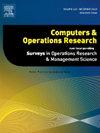交通网络设计问题的分散子目标遗传算法
IF 4.3
2区 工程技术
Q2 COMPUTER SCIENCE, INTERDISCIPLINARY APPLICATIONS
引用次数: 0
摘要
本文介绍了一种解决交通网络设计问题的新方法。这种技术基于遗传算法,并行使用多个子种群,每个子种群优先考虑最优解的不同方面。这些方面包括最大限度地减少换乘,减少弯路,并解决特定部分的需求。所有这些方面对于最小化平均乘客旅行时间都很重要,并且人为地改变目标函数中的每个权重因素使我们能够有效地逃避局部最优。我们的算法通过多样化种群并让每个子种群专注于定性解决方案的不同部分,在众所周知的基准实例上进行测试时证明了改进的性能。与目前最先进的技术相比,该算法将平均旅行时间减少了2%以上。此外,我们的方法产生一系列高质量和独特的解决方案,为决策者提供有价值的见解。该算法还在一个基于比利时农村地区的大型复杂实例上进行了测试,并显示出它能够找到当前交通网络的改进之处。本文章由计算机程序翻译,如有差异,请以英文原文为准。
A decentralised genetic algorithm with sub-objectives for the transit network design problem
This paper introduces a novel approach to the transit network design problem. This technique, based on a genetic algorithm, uses multiple sub-populations in parallel, each prioritising different aspects of the optimal solution. These aspects include minimising transfers, reducing detours, and addressing specific parts of the demand. All of these aspects are important in minimising average passenger travel time, and artificially changing each weight factor in the objective function allows us to escape local optima efficiently. Our algorithm demonstrates improved performance when tested on well-known benchmark instances by diversifying the population and letting each sub-population focus on different parts of a qualitative solution. This algorithm reduces average travel times by more than 2% compared to the current state-of-the-art. Additionally, our approach generates a range of high-quality and distinct solutions, offering valuable insights for decision-makers. The algorithm is also tested on a large, complex instance based on a rural area in Belgium and shows the capability to find improvements over the current transit network.
求助全文
通过发布文献求助,成功后即可免费获取论文全文。
去求助
来源期刊

Computers & Operations Research
工程技术-工程:工业
CiteScore
8.60
自引率
8.70%
发文量
292
审稿时长
8.5 months
期刊介绍:
Operations research and computers meet in a large number of scientific fields, many of which are of vital current concern to our troubled society. These include, among others, ecology, transportation, safety, reliability, urban planning, economics, inventory control, investment strategy and logistics (including reverse logistics). Computers & Operations Research provides an international forum for the application of computers and operations research techniques to problems in these and related fields.
 求助内容:
求助内容: 应助结果提醒方式:
应助结果提醒方式:


